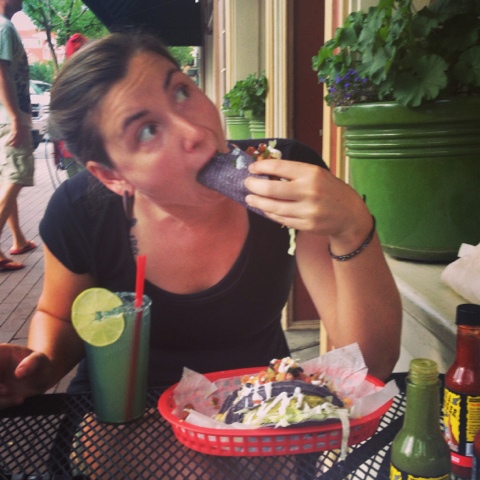The road to Durango looked steep according to the elevation map. Two big climbs, a dip, then the big descent into town. I thought it would take us 5 hours at least. It did take us 5 hours, but with a pie/espresso break, a few birding breaks, a flat tire break (first one), and a lunch break. So either the elevation wasn’t as bad as it seemed, or we’re getting stronger. Maybe both.
We pulled up to Durango around 1:30pm and reveled in being in town again. And not just a town, a tourist trap ski and adventure town.
Crepe stands! Artisan jerky! Craft breweries! We went a little overboard and ate blue corn tacos, margaritas, specialty chocolate truffles, and locally-brewed beer. Then we saw the new Bruce Willis movie and it was kinda awful but also great.
This is not your Ichetucknee tubing, folks. Sure, in Florida our rivers have snakes and alligators, but this mountain river has ROCKS. This is NOT a lazy river float! Travis was very gallant and splashed around desperately to guide me away from the boulders. And there were little rapids! It was very exciting.
Next stop was heartburn city, then Cousin Jonathan’s house. Jonathan is Travis’ first cousin. Their dads are brothers. Jonathan is a wilderness therapist, which sounds kind of hokey but he explained it and then it sounded miraculous. He goes a out into the woods with teenagers in crisis— some have tried to commit suicide, some are using drugs, some are on the last rope with their families. They go backpacking and talk about their feelings. I asked how they liked talking about their feelings, and he said they are reluctant at first but then they get really into it, challenging each other to be real. “You’re not being real, man! You’re being fake about your feelings!” Right?! Jonathan said he used to work as an occupational therapist seeing clients once a week, and they would take small risks and make a few small changes, but since these boys are in crisis and the backpacking therapy is so intense, he sees radical improvement pretty quickly. It definitely sounds like a difficult job but when it’s successful it must be very rewarding.
The next day in Durango was a “rest day”. It ended up being the most stressful day so far. My toes have been going numb clipped in to my pedals, so I wanted to get different cycling shoes (FULL product review at the end of the trip, FYI). We went to a mountain bike shop and the dude working was probably in his 40s and had clearly been working with bikes for a long time. When I told him my numb toes problem the first thing he said was that there are a lot of important nerves and blood vessels going through my pelvis, and I probably needed a new saddle. And new shoes. And that they would cost about $300 but I would feel great.
Maybe this wouldn’t be as frustrating if I hadn’t JUST bought a new saddle and shoes. Or if I hadn’t JUST walked in to another bike shop in Gainesville where the bike shop owner told me I had bought the wrong size handlebars, needed smaller brake levers, and different seat post. I’ve spent over $1500 on this bike over the past 3 years buying and switching out components to make it right for me, and my feet are falling asleep and now this dude is telling me I need to spend $300 more to fix it. I got mad. We left and ate lunch so I could decide what to do, and I cried over my pizza.
We still had a million things to buy— food for 4 days, iPhone speaker cords, emergency blanket, chlorine pills, a one hitter (it’s legal here…), whiskey, and my 4th pair of sunglasses (I brought a pair that was too small for my head, then broke two more pairs- actually Travis stepped on one and ran over the other). I think we spent about a million dollars. I made up my mind and ignored the bike shop dude, deciding to just buy different cycling shoes that had a more flexible sole and more padding. I haven’t tried them yet but I have high hopes that this numbing bullshit is over. Shopping can be stressful!!
Then shopping was over, and we went tubing. The Animas River runs right through town, and Cousin Jonathan and this roommates have tubes.
Cousin Jonathan was working late, so we cooked dinner with his roommates Mike and Gala. She made us a tasty dinner of curry coconut tofu noodles, and I contributed the kale.
Then Gala casually mentioned that they always have tons of leftover kale at her school garden, and now they’ll be able to grow it through the winter because they just completed construction on a thirty-foot geodesic dome greenhouse.
Wait WHAT.
She continued. Yes, the school she teaches at, Animas Valley Elementary, has a productive school garden that the children plant each spring and is maintained by the teachers over the summer, and is harvested by the kids when they come back in the fall. They use all the food they can in the cafeteria, but there’s usually so much extra kale that they donate it and get to take it home.
This opened up an entire conversation about the magical, mythical world of the Colorado school system’s Coordinated School Health program. Gala is head of her school’s Wellness Committee, and she has written and received grants from Whole Foods, the Bill and Melinda Gates Foundation, and Michelle Obama’s organization Let’s Move.
Here were our questions.
Q: Who takes care of the garden?
A: The teachers, but the kids do a lot of the work too.
Q: Isn’t the garden work yet another burden placed on public school teachers?
A: It is work, but it’s a huge part of the school’s culture and everyone is really proud of it.
Q: Do the kids actually eat the food?
A:. Yes, the cafeteria food is great and she eats lunch there every day, especially from the salad bar. Each week they have Risktaker Tuesday, where the kids harvest something from the experimental planting part of the garden- purple mizuna, tatsoi, hakurei turnips- then the cafeteria puts out samples so the brave kids can try something new.
Q: How does the cafeteria staff feel about the extra work of preparing fresh food in the kitchen instead of frozen, packaged processed food?
A: The cafeteria staff is totally on board and is proud of the food they prepare.
And there’s more.
The school hosts monthly cooking classes for low income kids and their families, teaching them how to prepare simple, inexpensive meals with whole foods. The kids get really invested in wanting to learn how to use the garden food, and nag their parents about cooking differently. The families go home with a bag of garden food to use throughout the week.
All the food used in the cafeteria is local and organic, and the school contracts with farms within 100 miles of Durango to grow their produce and meat. So these kids are eating local, grassfed, hormone-free beef and freshly-harvested vegetables from local farmers and ranchers. Every day. And they love it.
We explained that in Florida, the cafeteria budget is approximately 35 cents per child, so our kids eat the lowest quality processed crap imaginable. Gala said, ” Well that just doesn’t seem to be enough money. That’s why you need school gardens!”
If anyone else had said that, I would have rolled my eyes and thought, “YOU HAVE NO IDEA HOW HARD IT IS TO MAKE SCHOOL GARDENS WORK!!” These poor, overworked teachers are expected to run food gardens with no gardening experience; the cafeteria workers balk at having to do more work to prepare fresh food instead of just opening packages and heating them up; kids HATE vegetables and trying anything new and insist on covering everything with ranch dressing before they eat it; and low income parents, whose families are most at risk for diabetes and other food-related illnesses work multiple jobs and can’t afford fresh food, nor do they have the time to cook it. What seems like a very logical and easy solution to food insecurity and obesity is actually wrought with obstacles and frustrations.
However, it does look like Colorado has figured some of this shit out. It seems magical, and could be because of the more progressive culture out West, but it’s probably the result of many years of dedicated educators who area committed to the well being of their students. After all, Gala had a point: “If our students aren’t eating well, they’re just not going to learn as well.”








